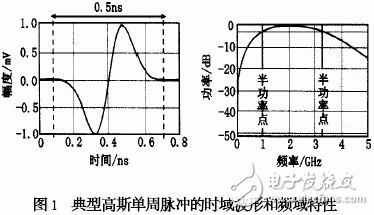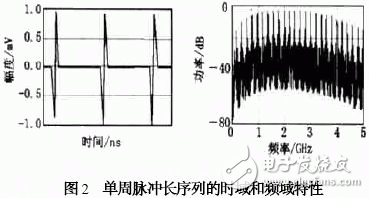Conventional communication systems are generally fixed frequency communication systems in which the information to be transmitted uses a fixed bandwidth, the signals are modulated onto a fixed frequency band, and then transmitted over a channel (wireless or wired). Any other signal in this channel will be interference with the wanted signal, so a communication system having this characteristic is called a fixed frequency communication system that is an exclusive channel. In contrast, wireless signals transmitted by Ultra Wideband (UWB) wireless communication systems or transient pulse radio systems do not occupy a fixed bandwidth, but span a wide wireless spectrum (typically between 1 and 10 GHz). ), and the power is very low, similar to the background "noise", so it will not interfere with other wireless signals operating at the same frequency.
The UWB communication system has many excellent performance characteristics, that is, the power spectral density of the signal is extremely low. The power consumption of the UWB system is much lower than that of the conventional radio technology, and it can cover a few miles with an average power of less than 1 mW. It works even with a low gain antenna. Particularly valuable is the low interference characteristics of other wireless systems and the strong multi-path interference capability that it has; it is simpler and less expensive to implement than a conventional spread spectrum system. It is because of the above characteristics that UWB communication technology has been widely used in personal communication, in-building communication, high-speed local area network, cordless telephone, security system, and close-range high-precision positioning.
TM-UWB technology and its characteristics
TM-UWB signal
In a general communication system, "wideband signal" refers to a signal having a large modulation bandwidth and a high data transmission rate. The ultra-wideband signal refers to the fractional bandwidth of the transmitted signal (FracTIonal Bandwidths, FBW) (meaning that the ratio of the signal bandwidth B to the center frequency fc, ie B/fc) is greater than 0.25 or 25%, which is usually steep through the pair. The impulses of the rise and fall times are directly modulated to obtain a modulated signal having a bandwidth of the order of gigahertz (GHz), which is also referred to as a "baseband signal" or a "carrierless signal." It has a wide bandwidth and the spectrum often extends from DC to GHz. The signal has high resolution, high processing gain, low stealing, large information content and ability to detect hidden targets, and thus is widely used.
The TM-UWB communication system is a new communication system that transmits data, voice and even images in a low-power, noise-like signal in the transmission medium. Since the wireless signal transmitted by TM-UWB technology spans a wide wireless spectrum and the power spectral density is low, it is similar to the background "noise" and therefore does not interfere with other wireless devices operating in the same frequency band.
Selection of transmission waveform
In general, the communication system using the TM-UWB technology does not emit a sinusoidal signal, but a Gaussian single-cycle ultra-short-pulse with a tightly controlled pulse interval, and a general working pulse width of 0.2 to 1.5 ns. It is 25 to 1 000 ns. Ultra-short-time single-cycle pulses determine the wide bandwidth of the signal. Such systems often use time (pulse position) modulation to carry information and channel coding. The TM-UWB communication system receiver directly converts the received RF signal into a baseband digital or analog output signal, and only uses the first-stage front-end cross-correlator to convert the electromagnetic pulse sequence into a baseband signal without using the intermediate frequency level in the conventional communication device. , greatly reducing the complexity of communication system Equipment. One bit of information is typically extended to multiple one-week ultrashort pulses, and the receiver correlates the appropriate number of pulses to recover the transmitted information.
Gaussian single-cycle ultrashort pulse
The most basic and important task in TM-UWB RF technology is to first obtain Gaussian single-cycle pulses that can be implemented in practical applications. Figure 1 shows the time domain and frequency domain characteristics of a typical Gaussian single-cycle ultrashort pulse (center frequency of 2 GHz).

The time domain and frequency domain mathematical models of Gaussian single-cycle pulses can be expressed as
Where A is the pulse peak amplitude, τ is a time delay length, here equal to the pulse duration, t is the time, f is the frequency, from which the center frequency f 0 = 1/τ can be derived, and the half power bandwidth Wb = f 0 &TImes; 116% This gives a Gaussian single-cycle pulse with a pulse width of 0.5 ns with a center frequency of 2 GHz and a half power bandwidth of approximately 2 GHz.
One-week pulse sequence
The TM-UWB system uses a long sequence of single-cycle pulses instead of a single one-cycle pulse in actual communication. Data modulation, channel coding, and the like are all achieved by varying the time interval of the pulse sequence. Figure 2 shows the time and frequency domain characteristics of a single-cycle burst. Due to the repetitive periodicity of the time domain signal rules, the spectrum is discretized, resulting in strong energy spikes that would interfere with conventional wireless communication devices and signals, which is undesirable.

Since very regular time-domain pulse sequences will not carry any useful information, while changing the regular periodicity of time-domain pulse sequences can also reduce the energy spikes that appear in the spectrum, time modulation is often used in information modulation and channel coding ( TM) technology or Pulse PosiTIon ModulaTIon (PPM) technology.
TM-UWB signal processing
Information modulation
